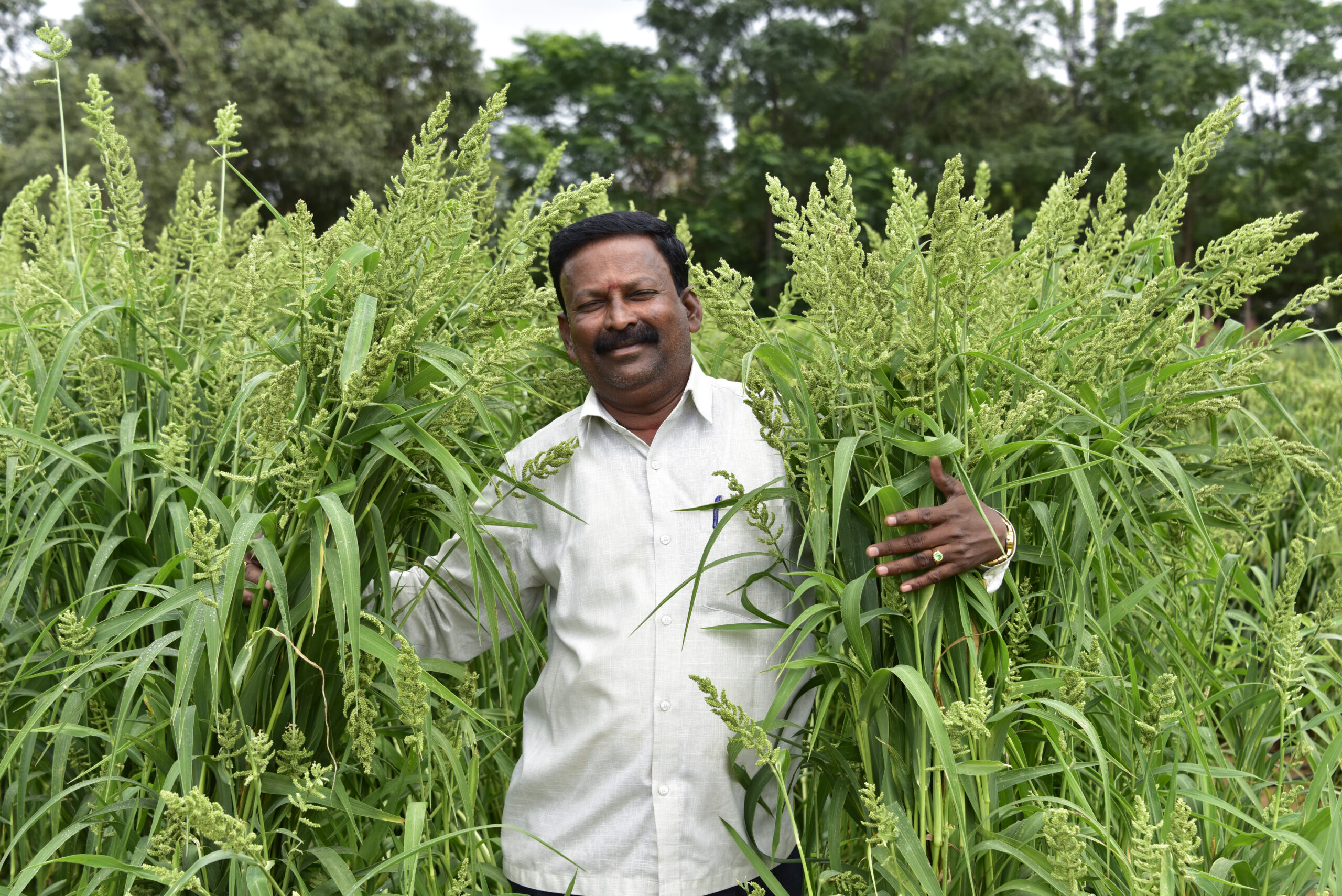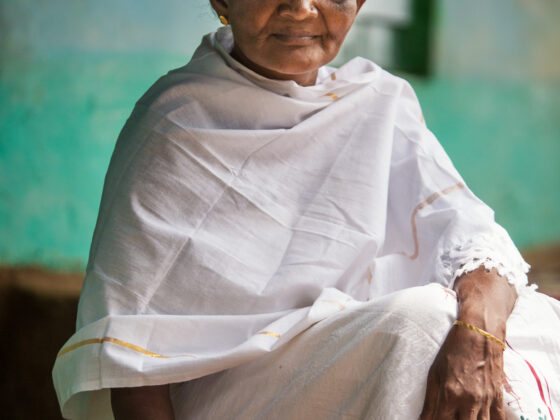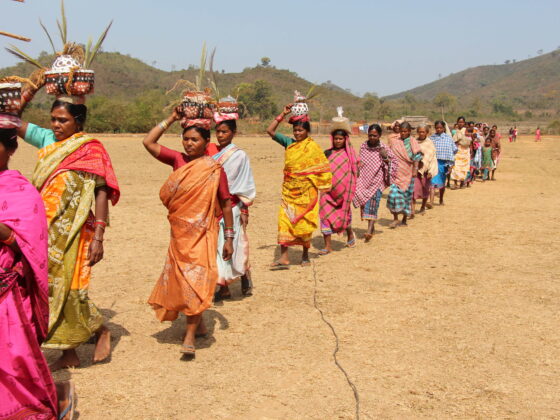As millets enter the culinary imaginations of urban dwellers, we must centre the land on which it grows, and the people who have preserved it.
When I visited Plantina Mujai in her village in Ri-Bhoi district, Meghalaya, on a cold morning in January 2020, she fed me a plate of liver and local rice—a starchy, glutinous, sweet variety that went perfectly with the assortment of fiery chutneys she had cooked. Mujai is a farmer in her 60s, and belongs to the Khasi community of the state. Even though she had cooked a large meal, she didn’t eat the rice, but took a fistful of krai (a local millet) from a small pot which she ate with a piece of boiled purple potato and meat.
When I asked her about her choice of eating the millet over rice, Mujai was indignant. “Rice is for young people! City people! For us, it is this. Old food for old souls,” she said, as she laughed contentedly into her plate. Mujai’s emphatic love for the local millet is not rare in Meghalaya with people of her generation. Also known as ‘Job’s tears’, krai—along with other varieties—has been known to feed the people of the river-clad, mountainous state for generations.
Krai is eaten with meat and vegetable stews, or as a porridge, and is also used to brew a local liquor in some villages. “It can be made sweet and savoury,” said Mujai, who recounts small laddoo-like sweets her mother made for her when she was a girl. Millets are indigenous to Ri-Bhoi’s hills, and the palates of those like Mujai are still adapting to the pervasive varieties of rice that are now eaten around them. “Krai has many flavours, many more than this basmati everyone likes to eat. And it keeps you full for long,” she said.
When I asked her about her choice of eating the millet over rice, Mujai was indignant. “Rice is for young people! City people! For us, it is this. Old food for old souls,” she said, as she laughed contentedly into her plate.
Millet cultivation in Meghalaya had been in decline since the 1990s. But in 2010, with assistance from NESFAS—the North East Slow Food and Agricultural Society based in Shillong—farmers began to pave a slow path for the revival of their beloved grain. With a team spread between the East-Khasi and Garo hills, NESFAS urges farmers to celebrate millet festivals, document songs and harvest rituals connected to the crop. The campaign titled ‘No Woman no Krai’ is an endearing call to the region’s past, and lays foundations for its future. It also invokes the most essential fact about krai—that Khasi women and the millet are tied together through history.
Preserving disappearing grains
Krai is one of thousands of millet varieties that have fed people in what comprises the Indian subcontinent. The broader family of millets is divided as major millets and minor millets based on the size of the area they are grown in, and that of the harvested grain. Major millets include sorghum (jowar) and pearl millet (bajra). The finger millet (ragi), foxtail millet, kodo millet, barnyard millet (sawan/jhangora), proso millet (cheena) and brown top millet (korale) among others are categorised under minor millets.
Even within broader categories, there are thousands of distinct varieties, depending on topography and climate. For example, cumbu, or pearl millet in Tamil Nadu, will differ from its counterpart in Nagaland. While healthy to eat, millets are, more importantly, suitable for land that is low in nutrients and irrigation through natural or artificial channels. The grain has been grown and adapted to various kinds of soil by farmers across the subcontinent for centuries, but has declined in its production in the last few decades.
According to Krishnaveni Nidadavolu, who was a coordinator at the All India Millet Sisters Network, millets have been historically grown by small-shareholder farmers, often from marginalised caste and indigenous communities. Nidadavolu referred to millet farmers as those who have been ‘farm labour’, and would work commercial crops for a landlord. “For themselves, they will have a small plot of land to grow on. This was usually less fertile because the most fertile land went to the most powerful in the village. This land didn’t get direct irrigation as well,” she said. But it was an important plot of land to the farmer.
“This is the land they ate from. Millets don’t require ploughing and labour, so it was an easy crop to grow through broadcasting the seed,” Nidadavolu added. Like she points out, it is small-shareholder farmers that have protected the diversity and presence of millets. Unlike commercial rice, millets can be grown on hilly terrain, lands in upper regions, and can resist conditions like drought that create food scarcity.

Even so, the grain has been deemed marginal and peripheral by elite Indian food culture. Mujai called this neglect an effect of the imposition of refined rice and wheat varieties in the market. She called these foods—like basmati, and hybrid wheat—’white foods’, which she juxtaposed with ‘coarse foods’ like millets. “White foods are considered aspirational by the market, and furthered by policy makers” Mujai said.
Janak Singh, a researcher at NESFAS, elaborated that the dwindling of indigenous millet varieties also has to do with the Public Distribution system’s focus on rice. “With the implementation of the Targeted PDS for families below the poverty line in 1997, rice became emphasised and highly subsidised. With rice being more easily available, cultivation of millet was considered secondary,” Singh said.
Across the subcontinent, the emphasis on polished rice and refined wheat accelerated the decline of indigenous foods of all kinds. “As the farmers required cash to meet the educational expenses of their children, they shifted their cultivation to broom grass—a tall, tufted, reed-like grass used for jharus or brooms—where the market was secure and people received higher returns,” Singh added about the East Khasi Hills, in particular, recounting what farmers in a district called Nongtraw had told him. This also occurred in states like Orissa, Karnataka, Punjab and Maharashtra where an overreaching demand of cash crops like cotton phased out traditional food crops grown for household consumption.
It is small-shareholder farmers that have protected the diversity and presence of millets. Unlike commercial rice, millets can be grown on hilly terrain, lands in upper regions, and can resist conditions like drought that create food scarcity.
The mainstreaming of high-yielding varieties of rice and wheat rice was emboldened and normalised by the Green Revolution of the 1960s—a set of agricultural reforms in which India lobbied to grow hybrid varieties of rice and wheat to meet growing issues of hunger. This purely quantitative method filled an immediate gap, but consequently starved farmland of nutrients, creating a much larger crisis of water, seed extinction and chemical poisoning that the country reels from today. Because the Green Revolution relied on hybrid seeds sourced from multinationals like Monsanto Mahyco, thousands of crops—rice varieties, vegetables and grain—were consequently rendered extinct.
The Green Revolution further pushed seeds that were dependent on machinery and fertilisers, creating a monopoly on land cultures by multinationals that was impossible for farmers to challenge or refute. Millets encountered a direct impact of these policies, and became more invisible than they were before. However, despite these challenges, farmers continued to preserve millet seeds and its culinary cultures persevered.
Building cultures of connectedness
In the last five years, however, the commercial and global presence of Indian millets has begun to change. In 2018, the Government of India declared a ‘year of millet’. Meanwhile, 2023 has been declared as an ‘International year of millets’ by the United Nations after it accepted a resolution from India to do the same. “As the largest millet growing country, we did not have a broad view of nutritional security that we were blessed with. But now, we see millets in the market as well, not just in small plots of land,” said Dr Dayakar Rao, the Principal scientist at the IIMR (Indian Institute of Millets Research).
Rao explains that a primary appeal of millets is that they grow under water-scarce conditions, in various types of soil. “50 percent of land in India is dryland,” said Rao. “Millets require 350-400 mm of water per acre, as opposed to rice, which requires 1200 mm. This makes it a viable choice.” He also noted how while farmers have believed in the crop for decades, it was that market forces didn’t comply. But now, millets are an urban-centric product desired by elite consumers which he believes can change things for farmers on the ground.
Millets have, as Rao points out, become popular with D2C portals; companies like Slurrp Farm and Soulfull have introduced millet-based replacements in cereal, snacks, biscuits, and flours. Since the Covid-19 lockdowns that began in 2020, millets have entered the culinary imagination of urban dwellers as a health and wellness option. Many of these focus on traditional foods, and envisage a process of ‘going back’.
However, while looking at wellness only through a focus on the consumer may be economically lucrative, these behaviours are a fickle way to determine the present potential and future of the crop. Health and wellness trends advocated to the urban elite prioritise weight-loss solutions, and catchphrases like ‘single origin’ or ‘organic’ almost never provide a deeper look into the food that is being advocated for and purchased. To ‘eat well’ requires a bit more thought than simply eating what makes one feel physically better, or is advocated to make bodies lean and thin. Even as millets are getting more attention from urban purchasers, the history of it, the people who grow it, the land cultures it comprises, and the histories of scarcity that it tells remain sidelined.
Nidadavolu distances herself from these sudden surges and large claims. To leave millet to the behest of market forces is not enough, but “more important steps need to be taken, like the 2018 campaign of Millet Network to introduce millets into PDS,” she said. The campaign was successful, but Nidadavolu also points to the importance of having diversity within the same so that a couple of dominant varieties of millet do not take over.
Even as millets are getting more attention from urban purchasers, the history of it, the people who grow it, the land cultures it comprises, and the histories of scarcity that it tells remain sidelined.
She explained that millets are grown in crop rotation, with a nut seed and some vegetables on a small piece of land by small-shareholder farmers. This way, they don’t have to buy much from the market, only salt. “Creating a monocrop culture of millets, where they are grown in exclusion, may threaten food-security and traditional farming techniques,” Nidadavolu said.
Many activists and farmers’ collectives have similarly warned against prioritising one variety or seed of millet over the others. Millets are of various types, and a ‘one size fits all’ approach of promoting only a handful of seeds and varieties to urban consumers can endanger the rest. Take Ragi or finger millet, for example, which is easier to process than some other minor millets, which is why, as a report in Mongabay India pointed out, ragi is gaining dominance over other varieties in Karnataka.
“Besides, unlike industrially grown varieties of rice, a harvest of an indigenous variety of millet can have grains of different colours and sizes. A market culture that recognises only standardisation can prove threatening for minor millet varieties,” Nidadavolu said. She recounted that farmers in Zaheerabad, Telangana, complained that unreasonable standards for how a millet crop should look meant that much of their crop was not purchased. Singh, in turn, noted that in Meghalaya, biodiversity was crucial, and more attention must be paid to what farmers want to grow and eat, and not only what they should.

Despite the expanding market of millets, bajra-growing farmers in Palasani, outside Jodhpur, Rajasthan, have not seen profits or investment promised to them after 2018. Rukhsana Mirasi, who works on a three-acre plot of land, said that bajra still only goes for Rs. 5 more than what it used to many years ago. Because expenses have increased, this provides no solace at all. “There are no pre-payments, and other solid methods to ensure they get the income they need from bajra. And here, we suffer from a very erratic climate and frequent drought. They do not take this into account,” Mirasi said.
Mirasi’s laments illustrate that while urban consumers may be interested in the crop, there is still little investment by governments and private companies in the lives of the farmers that grow it. Despite the new appetite for the grain, traditional methods and the issues that historic communities of farmers faced are still not discussed.
Through the country, food systems are presently designed for city-bred consumers with vast purchasing power, but the lands and people that grow what we eat need to be centred more when food futures are talked about. Cultures of connectedness need to be built between producer and consumer, so that the growers of food are allowed to exercise agency over what we eat. Moreover, land cultures, climates, and even the subjectivity of bodies, palates and appetites must be considered when we think about what constitutes food justice through the country. Even though millets come packed in various forms, it is the process, and picture on ground that consumers need to be cognizant of, and not just the one on the box.
Sharanya Deepak is a writer and editor from and currently in New Delhi, India. She writes about food, language, the commodification of culture and is currently writing more essays. You can read more of her work on the website. https://www.sharanyadeepak.com/




2 comments
Millets for the win!
Lovely read!